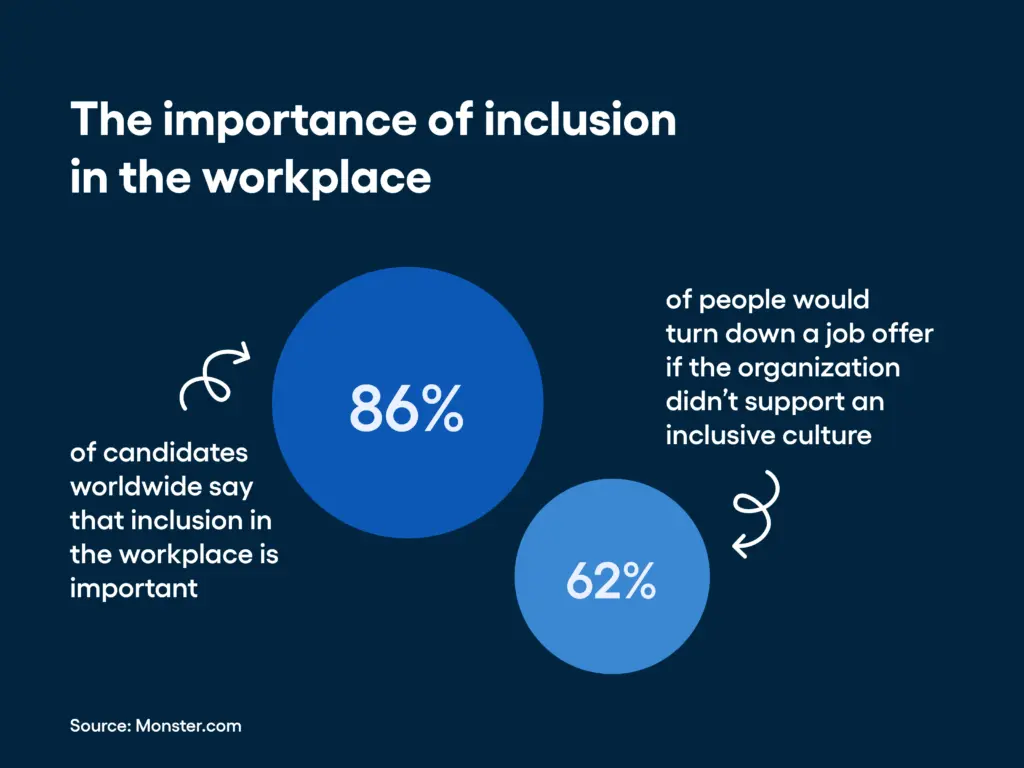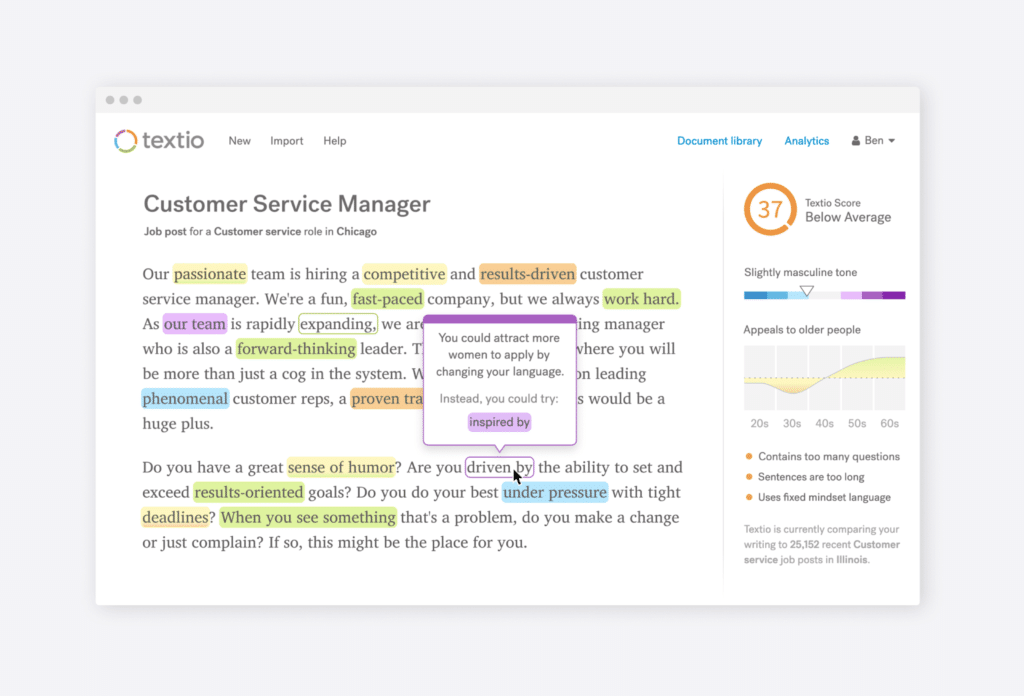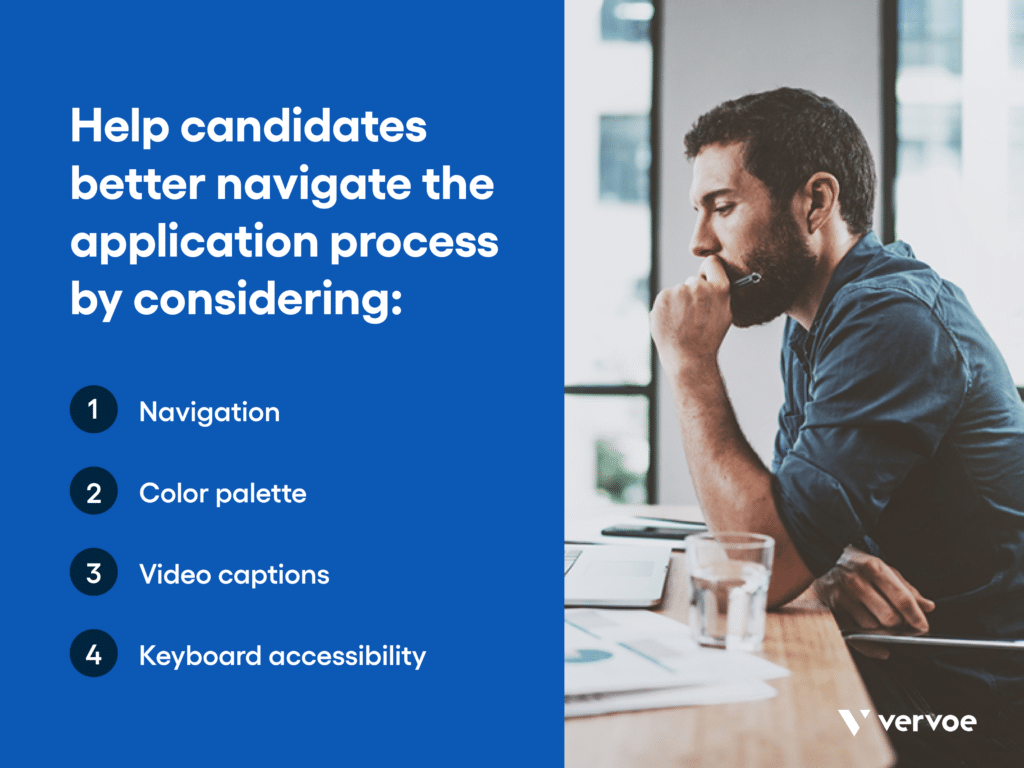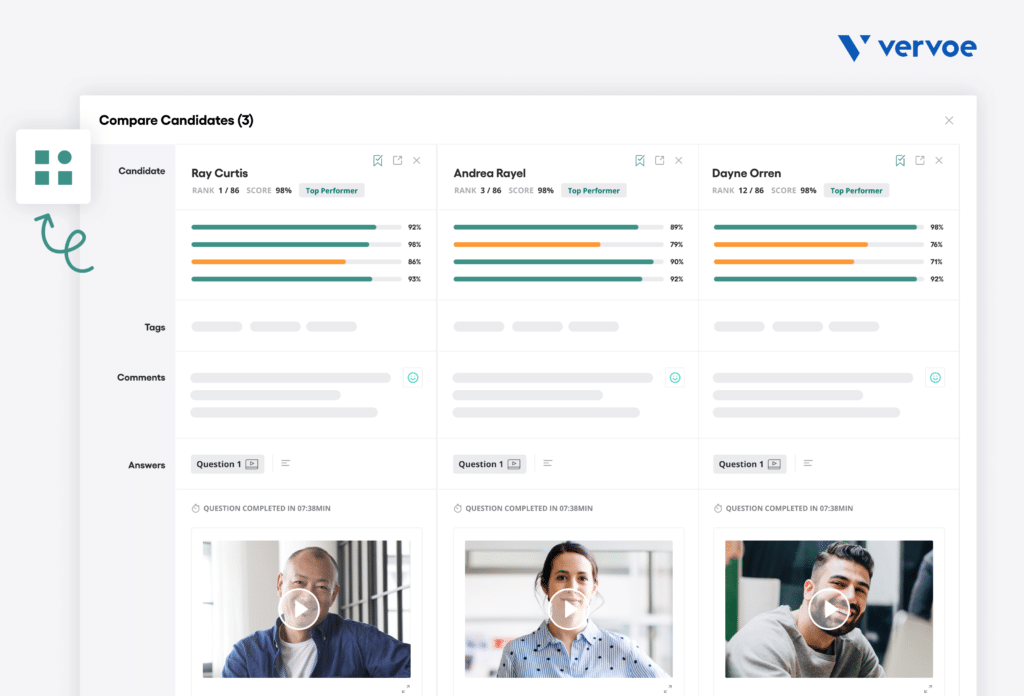Many companies are committed to building inclusive work cultures where employees from all backgrounds feel supported and appreciated. However, this commitment must start before the employee’s first day of work. Inclusive hiring is a key piece of the employee experience and can lead to higher employee retention, improved morale, and better business results. Here are some benefits of inclusive hiring practices, as well as some inclusive hiring best practices you can implement at your organization.
What is inclusive hiring?
Inclusive hiring is a recruitment process that not only recognizes the importance of diversity, but embraces the needs of diverse candidates with hiring practices that aim to level the playing field for all. Inclusive hiring practices work to overcome unconscious biases that can impact hiring teams; not only does inclusive hiring combat discrimination, but it also makes candidates feel valued and empowered throughout the recruitment process.
“Inclusive hiring allows you to find ‘hidden gem’ talent that other companies don’t recognize. And, you’ll make fewer mistakes, or mis-hires: candidates who look a certain part but ultimately fail to deliver results,” wrote the experts at Lever.
[Read: 5 Reasons Why Hiring Diverse Candidates Is Still Hard In 2021]
Inclusive hiring considers more than seeking candidates of different races or genders. Inclusive hiring takes into account the needs of candidates with cognitive differences, abilities, educational backgrounds, socioeconomic status, and more. By broadening your hiring practices to be inclusive of all, your company can attract a wider pool of candidates and increase your chances of finding the right fit — someone who can do the job well and help the company grow.
Benefits of inclusive hiring practices
Inclusion hiring benefits both candidates and companies. Candidates enjoy a hiring process that encourages them to showcase their skills and expertise, while recruiting teams get the information they need to extend an offer to the right person the first time.
Inclusive hiring has become the expectation, rather than the exception, from candidates all over the world. A global survey by Monster.com found that inclusion in the workplace is important to 86% of candidates worldwide. Furthermore, their research showed that 62% of people would even turn down a job offer if the organization didn’t support an inclusive culture. The next generation of workers — Gen Z and Millennials — expect companies to not only support their differences but to celebrate them.

Inclusive hiring is good for business, too. Hiring teams that emphasize inclusion from day one build companies that are more innovative, more profitable, more productive, and better at problem-solving. Inclusive companies are better positioned to learn about their customers, create products and services that meet a market need, and communicate more effectively. Inclusive hiring allows recruiting teams to build a pipeline of truly engaged candidates who will be motivated at every stage of the hiring process.
[Read more: 35 Impressive Diversity In The Workplace Statistics]
“Your revenue is tethered to culture whether you like it or not, and culture includes all of your contributors,” Ruhal Dooley, an HR knowledge advisor at SHRM told Monster. “The best talent available is proven to be everywhere, not just in some historically reserved place where everyone is the same. If the best talent yields the best result, diversity is necessary to compete.”
[Read more: Diverse Companies Perform Better]
Inclusive hiring encourages companies to look at the skills and expertise that really matter, not things like education or gender that could miscue a person’s ability. How can you begin to benefit from inclusion hiring? Consider implementing some of these inclusive hiring best practices.
8 Inclusive hiring practices
Inclusive hiring doesn’t just happen overnight. It takes investing in specific parts of the hiring process to make sure all candidates can not only participate, but put forth their strongest case for joining your company.
1. Write inclusive job descriptions
The language used in job descriptions can play a big role in inclusive hiring. Research shows that words like “strong” and “competitive” are perceived as male-specific and can deter female candidates from applying. Likewise, terms like “sensitive” dissuade male candidates from submitting an application.
The complexity of your job description also plays a role. Use short, simple sentences that emphasize the must-have skills for a candidate, rather than an exhaustive list of qualifications. Many companies inadvertently discourage diverse talent from applying by setting too high a bar. A 2017 Allegis Group talent acquisition study revealed that only 28% of hiring managers expect candidates to meet every qualification listed. Listing every qualification under the sun may intimidate candidates who would be a good fit from applying.
Finally, pay attention to your formatting. Italics and underlining can make it difficult for candidates with dyslexia or visual impairments from reading your job posting. Stick to large fonts and bold words that you wish to emphasize.
Try using tools like The Gender Decoder or Textio to make sure your job descriptions are as inclusive a possible.

2. Make sure your career site is accessible to all.
In addition to writing your job descriptions carefully, it’s critical to make sure your careers site is accessible to all viewers. “Digital accessibility refers to designing devices, products and environments such that people with disabilities or sensory impairments can successfully use the device or product or navigate the environment,” explained SHRM.
As you build or update your careers page, there are a few different things to pay attention to that can help candidates better navigate the application process. Consider these elements:
- Navigation: Do you have detailed and consistent navigational elements in the page structure, such as headers, titles and lists, that can make it easy for an assistive screen reader tool to scan?
- Color palette: Does your site use proper color contrast so those with visual impairments or color blindness can differentiate between design elements?
- Video captions: If you have a video on your careers page, do you have transcripts and captions so aurally-impaired prospective applicants can still consume your content?
- Keyboard accessibility: Can someone navigate your website without the use of a mouse?
There are many inclusive design elements that you can build into your website to help diverse candidates connect with your organization. For more, refer to the Web Content Accessibility Guidelines (WCAG).

3. Provide bias awareness training for hiring teams
One of the most difficult parts of combatting unconscious biases is that they’re…unconscious. Few recruiters are aware that they are operating using heuristics (mental shortcuts) that incidentally benefit some candidates more than others. Unconscious bias training, as well as training on fair hiring practices, can help shed light on hiring practices that may be unfair.
Offer bias awareness and fair hiring training to anyone participating in the hiring process (not just recruiters). Unconscious bias training should be offered regularly to all employees to ensure they are supported and supportive of the inclusive work culture you are building. Ideally, this training can be combined with blind hiring and other inclusive practices that layer support for diverse candidates as they go through your hiring process.
4. Add inclusion to your employer branding
Publicize your efforts to be diverse and inclusive to attract more diverse candidates to your organization. Inclusive recruitment must be meaningful and authentic: go beyond simply publishing stock images of diverse people on your careers site. Show (with permission) photos and videos of your diverse team at work. Share information about your employee resource groups, your DE&I statement, and, if possible, be transparent about your progress toward building a more diverse workforce.
Capturing the true benefit of a diverse workforce means not just hiring someone for their background, but also their experience, ability, and perspectives. The employer branding that you use in tandem with inclusion hiring allows you to showcase the way your organization values a range of abilities and skill sets.
5. Use tools that keep candidates engaged
Technology can play a major role in inclusive hiring. First, it can help even the playing field by standardizing important parts of the hiring process. Second, it can help recruiters keep candidates engaged throughout the experience.
By definition, inclusive hiring requires leveling the playing field for all candidates. One way to do that is to replace resume screening with an on-the-job simulation like Vervoe’s skills assessments software. A skill test with questions crafted to mimic the role allows candidates to perform tasks relevant to the job they’ve applied for and showcase their abilities in the process.
Moreover, an AI diversity recruiting software tool can use an algorithm to score the results, ranking candidates rather than eliminating them. Vervoe’s smart algorithm delivers recruiters a list of the top candidates after their qualifications have been validated; recruiters can then invite candidates to the interview stage and beyond.

Skill tests often result in high levels of candidate engagement, too. Companies that use Vervoe’s assessments experience a 97% candidate completion rate, which is among the highest engagement rates in the industry. Candidates love the opportunity to stand out from the crowd.
[Read more: Skill Tests: Complete Guide To Assessments + Examples]
6. Utilize diverse interview teams
Inclusion hiring benefits from diverse hiring teams. At Intel, for instance, requiring each interview panel to require at least two women and/or members of an underrepresented group empowered the company to grow diverse new hires by 41% in two years.
When candidates go through the hiring process and engage with people from many different backgrounds, it can validate that yours is a truly inclusive culture. Interview teams that are made up of unique individuals from different parts of your organization can create a more inclusive environment for new people. They can also help you ask different questions, bring new perspectives to the interview, and improve the quality of your vetting process.
7. Measure your efforts
Inclusion can be somewhat nebulous and difficult to measure. How can you assess how empowered your candidates feel throughout the hiring process?
Inclusivity is manifested in the policies and procedures that your company creates to make everyone feel valued. The psychological safety a candidate feels is quite subjective, especially in an environment as personal as a job interview.
One way to measure the inclusiveness of your hiring process is to offer a short survey to the candidates who exit the hiring process, whether voluntarily or because their application was rejected at a later stage. Ask these questions:
- Do you feel you have an equal opportunity to succeed here and reach your full potential?
- Do you feel that the hiring process provided an opportunity to showcase your best possible skills, qualifications, and expertise?
- How have you observed and/or experienced bias, discrimination, and inequity?
[Read more: How To Measure Diversity, Equity And Inclusion]
Exit interviews can help you assess how well you’re performing on candidate inclusiveness. You can also look at data from the hiring pipeline to see where diverse candidates are dropping out. For instance, if you see a large number of candidates starting the job application questionnaire and not finishing it, that may indicate there are too many questions or that the format isn’t user-friendly.
8. Invest in inclusive benefits and compensation
Lastly, inclusive hiring is only as good as the culture that follows: how inclusive is the employee experience?
“The key to inclusion is understanding who your employees really are,” reported Harvard Business Review. Building an inclusive culture may mean offering compensation that levels the playing field for men and women, offering mentorship programs for minorities, investing in employee resource groups, or instituting gender-neutral parental leave policies. Think about what benefits and compensation can make employees feel supported and maximize the contribution of diverse employees.
[Read more: The Ultimate Guide To Diversity Hiring In 2021]
For more resources and help improving inclusive hiring practices at your business, read about Vervoe for Diversity Hiring and subscribe to our newsletter for future updates.




















